Uncategorised
The Weather in Combe Raleigh in 2014 - (Published in the Raleigh Rag)
It’s been an interesting year for the weather in general, but the wet and stormy weather at the beginning of the year made a challenging start for 2014 with approx. 200mm of rain each month in January and February. A warm summer followed, ensuring a good vegetable crop although a poor quantity of apples compared with 2013. September was unseasonably dry and the cold snap didn’t really appear until the end of December.
Weather monitoring has been fairly reliable this year, although an equipment failure caused some odd readings in March, which have been corrected. We’ve not had much time to add additional sensors this year, for some reason! We do need to add some height to the anemometer so expect that to appear on top of the Old School shortly. Some more work on the soil sensors needs to be completed too.
Recorded weather
The year was wetter with 1115.2 mm compared with 839.4mm rainfall in 2013. However 2012 still remains wettest with 1288.2 mm. Wettest month was February with 204.8 mm and 28 rain days (Yes, it rained every day !) There were 120 precipitation days with more than 2.5mm rain recorded. The driest month was September with 16.2 mm and 6 rain days.
The Met Office has confirmed that September was the driest month on record for the UK in a series from 1910.
It was also a warm year, with an increase in average temp of 1°C over last year. Our temp average of 11.1°C is above our reading last year (10.1°C) and also above the average temp for the UK at 9.9 °C. Temp data recorded 38 days above 22°C, with only 2 days dropping below -5°C.
The Met Office has confirmed that 2014 was the warmest overall year since 1910.
No recorded snow fall, but 30 instances of ground frost.
Average temperature = 11.1°C
Average humidity = 86%
Average dewpoint = 8.2 °C
Average barometer = 1012.5 mb
Average windspeed = 1.1 mph
Average gustspeed = 2.6 mph
Average direction = 186° ( S )
Maximum windspeed = 20.7 mph 203°(SSW) on 14th Feb at 20:53
Maximum gust speed = 40.3 mph 180°( S ) on 12th Feb at 12:34
Total windrun = 9834.2 miles
Rainfall for year= 1115.2 mm
Maximum rain per minute = 7.9 mm on 22nd May at 09:44
Maximum rain in 1 hour = 10.4 mm on 19th September at 07:47
Record Daily Rainfall = 25.2 mm on 1st January
Maximum temperature = 28.3°C on 26th July at 15:36
Minimum temperature = -6.3°C on 29th December at 06:55
Maximum pressure = 1044.4 mb on 29th December at 20:23
Minimum pressure = 969.8 mb on day 14th Feb at 20:36
Maximum UV Index= 8.8 on 5th July at 12:50
Maximum Solar= 1322 W2m on 28th June at 12:50
Maximum Sunshine Hours= 11.6 hrs on 5th June
Total Sunshine Hours= 951.9 hrs
Maximum Radiation Exposure = 14.71 cpm ( 0.13 µSv) on 7th March
Minimum Radiation Exposure = 7.5 cpm ( 0.06 µSv) on 1st November
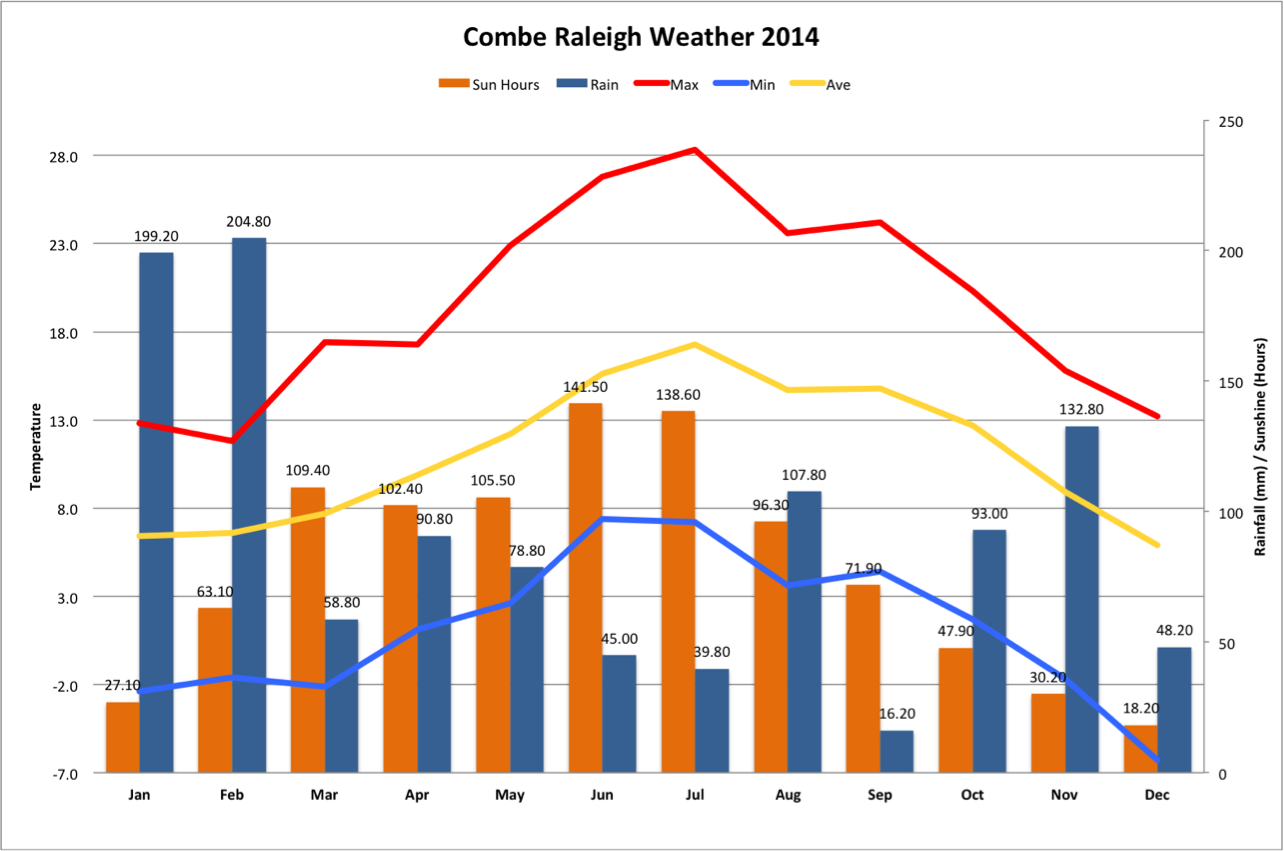
The Weather in Combe Raleigh in 2013 - (Published in the Raleigh Rag)
Remembering the 2013 weather year, Combe Raleigh experienced cold spells in January to March, a warm dry summer and closed with a warmer than usual winter. We even had 10cm of Snow on 19th January.
At The Old School, we run an internet connected weather station. We run 24 hours a day, recording the weather and also forecasting the next 3 days with advanced climate modelling software.
Radiation measurements are made automatically every 6 seconds by a Geiger counter connected to the station, and calculates the internal radiation levels within the Old School. This is predominantly Radon Gas, which is present in the earth, emitting alpha radiation. The recorded levels are very low, which is representative of the geological structures under Combe Raleigh.
Weather data recorded indicated that March was very much cooler than 2012, 2.2°C lower overall average, although the year was dryer with 1288.2mm in 2012 but 839.4mm in 2013. As the years pass, this comparative data will be more interesting !
The Highs and Lows of 2013 ;
Average temperature= 10.1°C
Average humidity= 87%
Average dewpoint= 7.9°C
Average barometer= 1015.3 mb
Average windspeed= 1.0 mph
Average gustspeed= 2.4 mph
Average direction= 102° (ESE)
Maximum windspeed= 13.8 mph 203°(SSW) on 23rd December at 13:33
Maximum gust speed= 29.9 mph 135°( SE) on 23rd December at 22:22
Total Wind run = 8456.9 miles
Rainfall for year= 839.4 mm
Maximum rain per min= 2.0 mm per min on 22nd January at 01:17
Maximum temperature= 30.4°C on 13th July at 16:00
Minimum temperature= -4.9°C on 14th March at 06:55
Minimum humidity= 34% on 13th July at 17:37
Maximum pressure= 1042.1 mb on 11th November at 20:48
Minimum pressure= 973.6 mb on 1st December at 17:38
Maximum UV Index= 9.2 on 3rd July
Maximum Solar= 1324 W2m on 30th June
Maximum Sunshine Hours= 11.6 hrs on 5th June
Maximum Radiation Exposure = 14.69 cpm ( 0.13 µSv) on 7th March
Minimum Radiation Exposure = 10.29 cpm ( 0.095 µSv) on 10th July
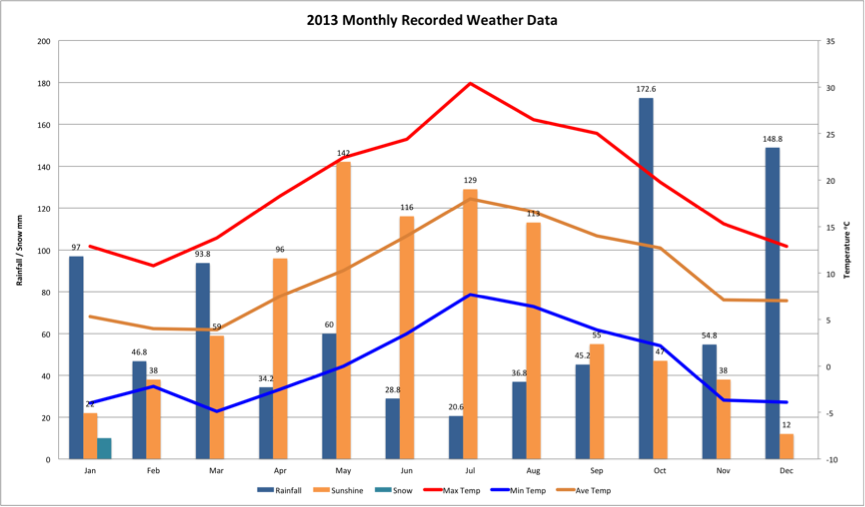
Weather for the Year - 2012 (Published in the Raleigh Rag)
Hopefully this year has not been representative of the normal weather in Combe Raleigh ! Being our first year in the village, the weather has been rather wet and whilst not particularly cold not hot either, as you would expect in a valley from which Combe Raleigh takes its name.
With the dry spell at the beginning of the year, with January, February and March indicating a dry and the highly announced drought that was to follow for the year ! This was preceded by a very dry 18 months previously, however. From April onwards, the rain came in abundance, with well over the expected amount of rainfall falling on numerous days.
April was also the month that taught us that the water well here at The Old School needs around 100mm of rain to re-fill it after I decided it would be a good idea to empty it in March to check the state of the walls and the depth/silt levels. We then had 3 weeks of dry weather where I thought I'd wasted all my drought emergency vegetable watering supply !!
May was a month of contrasts with a wet start, tailing off to a warm and the notional summer for 2012. The Vegetable garden grew well because of this contrast, although later conditions did constrain some crops.
June, July and August just rained, lots. We have got used to wet weather in the summer, but not to this extent. That said, a number of sunny spells did appear at times which warmed up the temperatures but as can be seen from the statistics, not much to indicate summer.
September and October, more of the same !! That said, September was much dryer by volume of water, although small showers and heavy dew set in and still produced notable precipitation.
November and December, with more rain and the compounding effect of months of wet conditions, widespread flooding across the country resulted in a number of properties being damaged and flooding in the Main Street of Combe Raleigh. The main railway line from Exeter to Waterloo was also disrupted outside Honiton, resulting in rail replacement buses until the ballast was replaced. Prior to Christmas, the Cowley Bridge Junction on the Penzance to Paddington line also flooded with the loss of service, along with the Tarka Line.
2012 was notable with no significant snowfall, although a few flakes were seen in February.
The weather statistics collected over the last twelve months show some interesting values, highlighted here ;
When comparing with the Exeter Airport Long time average values (1980 - 1990), shows a much wetter and colder weather year in Combe Raleigh. Note the Yellow line denoting the monthly average of temperature always close to the long term minima temperature value.
The rainfall comparison clearly shows the first three months being very dry in comparison with the long term average at EGTE, but April makes up for all of that.
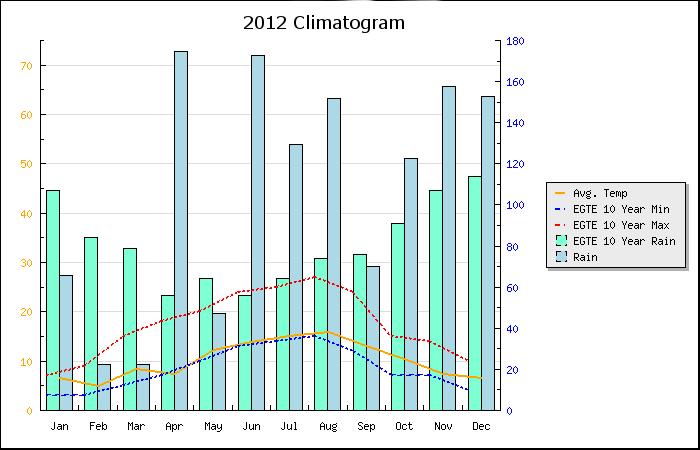
SOTA Dipole 2004 - 2013
With the 2m SOTA Beam available for VHF, but not a lot of activity on this band around here ... I decided to start building a Portable Dipole, based on the mounting principles of the SOTA Beam. 40 and 20m seemed to be the Bands of choice on SOTA, so off I went with a prototype made from some plastic which didn't make it to the Summit so a re-think was in-order. The new design is based on the familiar 20mm PVC Conduit, much like the SOTA Beam.
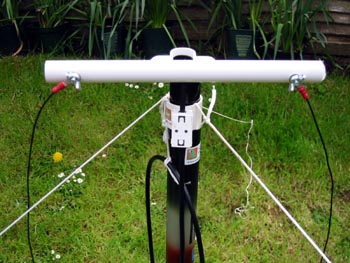
Centre Fed Inverted V Dipole
Parts
1 x 250mm Length 20mm Conduit
1 x 20mm Conduit Clip
2 x 4mm Bolt - Flat Head
2 x 4mm Wing Nut
1 x 12m Length RG-58 Co-ax
2 x Flat Slide Connector
2 x 5.6m Length 0.16/24 Stranded Wire
1 x Ferrite Choke
The Feed point BALUN is provided by the Ferrite snap-on being used as a choke.
Assembled on a SOTA Pole and Tuned via MFJ Tuner - 5 9 into Sweden using 35w - Inverted V layout, E/W Arrangement at home QTH. Next stage to Tune to the Mid Band Point for 14Mhz and 7.0 Mhz

The elements tuned successfully for the 20 m Band, with a Flat SWR over most of the band, from 14.000 to 14.220, with an Elevated SWR out to 14.350. Element lengths required about 200mm trimmed from each, from what was originally calculated.
Used in the 2005 ARI International DX Contest, handled 100w without any signs of distress, or high SWR. This antenna is used on a regular basis for SOTA and other portable operations on 20m. Several years later, and it's still going strong.
EZNEC Plot

AIM 4170C Plots
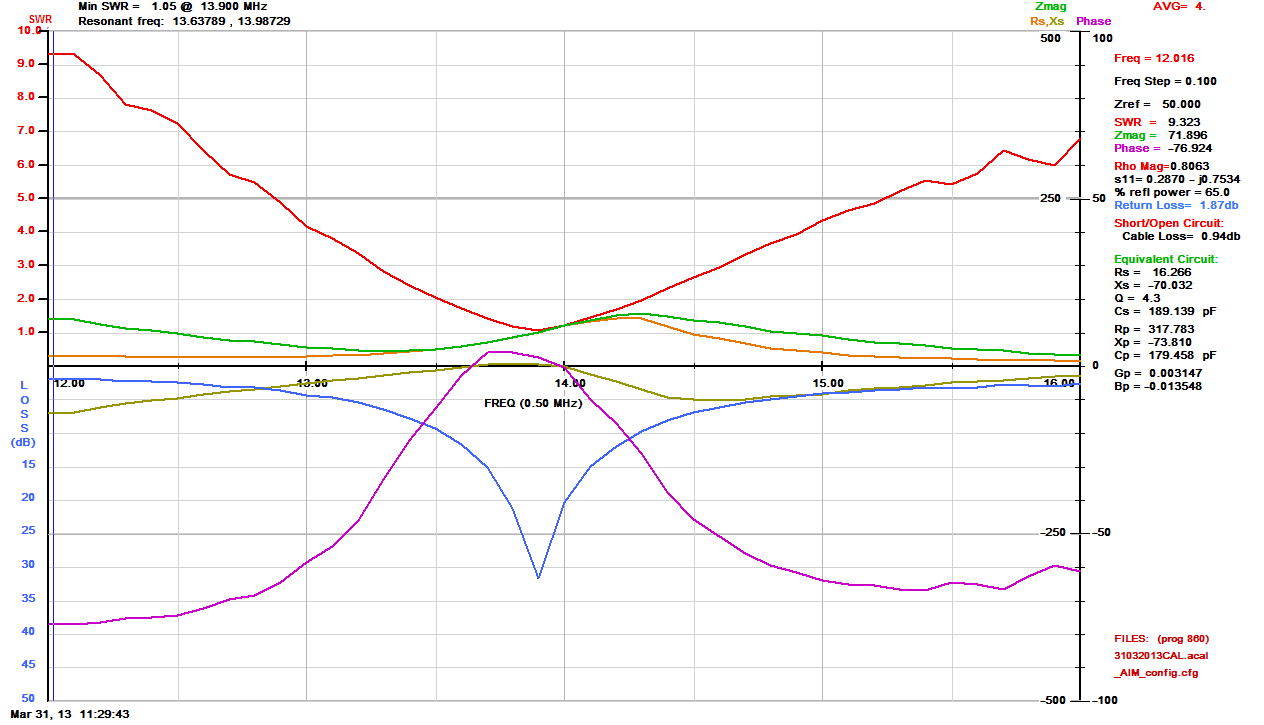
20m Band
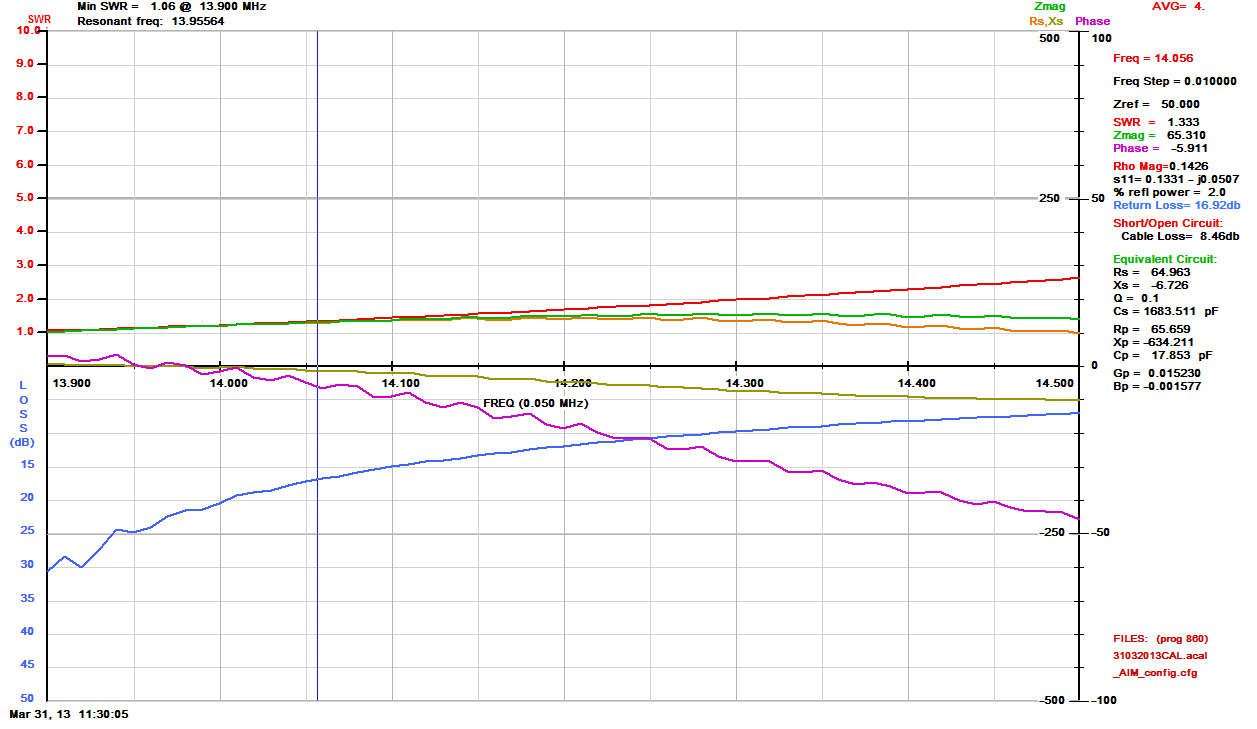
12 Mhz - 16Mhz Sweep
